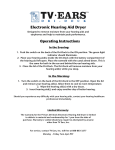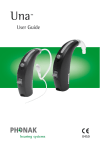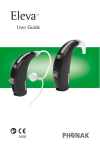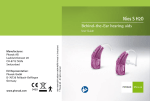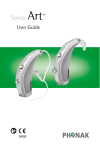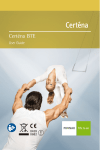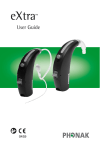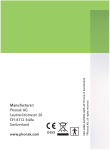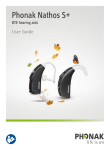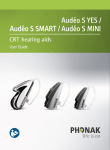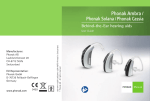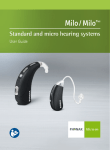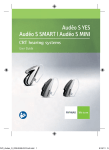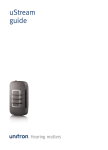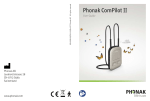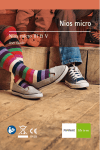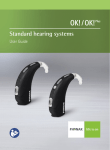Download User Manual Una BTE
Transcript
Una ™ User Guide Contents Welcome 5 Description 6 Short introduction Inserting the battery Switching ON / OFF Controlling the volume Selecting a hearing program 8 8 8 9 9 Preparation Replacing the battery Tamper proof battery compartment Identifying left and right instruments Inserting Una hearing aid with earmold into your ear Inserting Una hearing aid with Fit’nGo slim tube or Fit’nGo standard tube into your ear 20 Operation Switching ON / OFF Controlling the volume Selecting a hearing program Telecoil (optional) 24 24 26 28 29 2 10 10 13 15 16 FM communication with Una (optional) Attaching / removing MicroLink FM receiver ML9S / Audio shoe AS9 Manual selection of an FM program Multi-frequency FM products 30 31 33 34 Care and maintenance Wind and Weather Protector Open fitting: Fit’nGo slim tube 36 36 39 Troubleshooting 42 Important safety information 44 Service and Warranty 49 Compliance information 51 Information and description of symbols 52 3 This user guide is valid for: Non wireless models Una M Una M AZ Una SP Una SP AZ CE mark applied 2007 2007 2007 2007 The following table shows what battery you need for your hearing aid model. Model Zinc air battery size (marking on package) IEC code ANSI code M M AZ SP SP AZ 13 13 13 13 PR48 PR48 PR48 PR48 7000ZD 7000ZD 7000ZD 7000ZD 4 (orange) (orange) (orange) (orange) Welcome Your new hearing aid is a premium Swiss quality product. It was developed by Phonak, one of the world`s leading companies in hearing technology. Your hearing aid offers the most modern digital hearing technology currently available on the market. Please read these user instructions thoroughly in order to benefit from all the possibilities your new hearing aid has to offer. With proper use and care, you will be able to enjoy your hearing aid for many years to come. If you have any questions, please consult your hearing care professional. Phonak – life is on www.phonak.com 0459 5 Description 햲 햶 햷 햳 햴 햵 Una hearing aid with earmold 햲 햳 햴 햵 햶 햷 6 Microphone inputs with Wind and Weather Protector Program switch (TacTronic) Volume control Battery compartment with ON / OFF switch Hook / sound output Individual earmold (detachable) 햲 Una hearing aid with Fit’nGo slim tube 햶 햳 햷 햲–햵 see left diagram 햶 Slim tube 햴 (sound output) 햷 Dome (detachable) 햸 Retention Una hearing aid with Fit’nGo standard tube 햸 햵 햶 햲 햸 햲–햶 햳 see left diagram 햷 Fit’nGo standard tube 햸 Fit’nGo wax protector 햴 햹 Retention 햷 햹 햵 7 Short introduction Inserting the battery More details see page 10 Switching ON / OFF More details see page 24 ON 8 OFF ON Controlling the volume More details see page 26 Volume up Volume down Selecting a hearing program More details see page 28 9 Preparation Replacing the battery Use battery size 13 for all Una behind-the-ear instruments (BTE). Using the nail grip, open the battery compartment completely and remove the old battery. Remove the protective foil from the new battery. 10 Insert the new battery with the “+” sign (flat side of the battery) in line with the “+” marked on the battery cover and close it. 11 Preparation Replacing the battery ! Handle the battery cover with care and do not use excessive force. ! If there is any resistance when shutting the cover, ensure that the battery is inserted correctly. ! The cover may not close properly if the battery is upside down, and the instrument will not work. ! When your hearing aid is not in use, leave the battery compartments open to allow any moisture to evaporate. We recommend to only use batteries which your hearing care professional approves and sells. Low battery warning Your hearing aid will indicate with a double beep, that the battery soon needs to be changed. You typically have up to 30 minutes to change the battery, however this can differ and might be considerably shorter. We recommend that you always keep a spare battery on hand. 12 Tamper proof battery compartment To protect children from the dangers of playing with batteries, a special locking system may be mounted on the hearing aids. This locking system can also be used for identifying left and right hearing aids (see page 15). To lock the battery compartment after it is closed: Use a Phonak screwdriver and turn the screw to its middle position (slot vertical). To unlock the battery cover: Turn the screw until it stops. 13 Preparation Please make sure that the screw is not in the locked position when you close the battery compartment. Locked Unlocked The ON / OFF switch is not available when the battery compartment is locked. To switch the hearing system OFF, it is necessary to unlock the tamper proof battery compartment. 14 Identifying left and right hearing aids It is important to use the correct hearing aid for each ear. Your hearing care professional can mark the hearing aids for you. The color code on the housing will identify left and right hearing aids. The color code is as follows: red = right blue = left 15 Preparation Inserting Una hearing aid with earmold into your ear Using the hand on the same side you wear your hearing aid, grasp the earmold between the thumb and index finger. Raise your hand to your ear making sure the canal portion of the earmold faces your ear. Tilt your hand slightly forward. 16 Place the canal portion of the earmold inside your ear canal. If it is difficult to get it into place, stretch your ear by pulling it gently backwards and upwards with your other hand. When the canal portion is in place, twist the earmold backwards so that it fits into the concha and the helix portion is under the fold. 17 Preparation Now position the hearing aid behind the ear. Be careful not to twist the tubing. 18 Check the placement of the earmold by tracing the contour of the ear with your finger. To remove your hearing aid, grasp the earmold, not the tubing, and pull it out of your ear gently but firmly. 19 Preparation Inserting Una hearing aid with Fit’nGo slim tube or Fit’nGo standard tube into your ear Before inserting the dome, check that it is correctly attached to the tube (dome length is completely slided over the tube). Place the hearing aid over the top of your ear 햲. 햲 Hold the slim / Fit’nGo tube where it attaches to the dome or Fit’nGo wax protector 햳 and gently push the dome into your ear canal. 20 The dome or Fit’nGo wax protector should be placed far enough into the ear so that the slim / Fit’nGo tube lies flush with your head 햳. 햳 Place the retention tail of the slim / Fit’nGo tube into the bowl of your concha 햴. 햴 21 Preparation Closed domes The closed dome has a different design than the open dome, refer to picture. The closed dome consists of two fins overlapping each other. Before inserting the closed dome into the ear canal it is important to check the position of these fins. The bigger fin must be positioned over the smaller fin, see picture 햵. If the position is incorrect 햶, you can easily adjust it with one finger, just bend smoothly the bigger fin forwards and then back again so that it is overlapping the smaller one, see picture 햷. Make also sure that the slit of the closed dome is in a horizontal position on the tube unit, as shown in picture 햵. Your closed dome is ready to be inserted into the ear, refer to page 20. 22 Correct position 햵 Wrong position 햶 Moving the fins 햷 23 Operation Switching ON / OFF Switching OFF Using the nail grip, slightly open the battery cover until it snaps into its OFF position. Switching ON Close the battery compartment. Your Una hearing aids are always working in the initial hearing program, and at the preset volume when turned ON. 24 Your hearing care professional may have delayed the activation of your Una hearing aid after switching ON (9 or 15 seconds), in order to avoid any disturbance when placing it on your ear. The activation is confirmed by an acoustic signal. 25 Operation Controlling the volume The volume of your Una hearing aid can be adjusted above or below the preset volume. Volume up Volume down 26 Note • A beep confirms each action on the volume control. A double beep indicates that you have reached the limit of your volume control range. • If not required, your hearing care professional can remove the volume control switch. 27 Operation Program selection Upon request, your hearing care professional can program for you additional individual hearing programs dedicated to specific hearing situation or FM (wireless communication) use. Important Ask your hearing care professional to print out the complete description of your individual hearing programs and how to access them with your program switch. 28 Program switch (TacTronic) The program switch allows manual toggling between the different hearing programs your hearing care professional may have activated in your Una hearing aid. Telecoil (optional) Your hearing care professional may have activated a Telecoil (T-coil) in your Una hearing aids. The programs with T-coil are used to listen to telephones that are compatible with hearing aids or via inductive loop systems (present in some school settings, theaters, churches etc.). 29 FM communication with Una (optional) Your Una hearing aid is equipped with Direct Audio Input (DAI). It allows you to fully benefit from the high-end FM communication systems from Phonak. FM systems greatly improve communication when noise, distance or reverberation is a problem. A wireless FM communication system consists of a transmitter (e.g. EasyLink) and a receiver. The transmitter is placed near the sound source or is directly connected to your TV, radio or telephone, or linked via Bluetooth to your mobile telephone. It transmits the signal via radio to your MicroLink receivers attached to the Una hearing aids. Your multi-frequency MicroLink ML9S or MicroMLxS, fixed onto your Una hearing aid, is the world’s smallest high-end FM receiver. For more information about the use of your FM system, please refer to the appropriate FM transmitter user guide. 30 Attaching and removing MicroLink FM receiver ML9S and Audio shoe AS9 Your hearing care professional has already prepared your Una hearing aid for use with an FM receiver. To attach the MicroLink receiver ML9S or the audio shoe AS9, firmly hold it in your hand and push the small black locking systems together with the bottom of the hearing aid 햲. 햲 햳 햲 31 FM communication with Una (optional) Then, push the hearing aid down until it snaps in 햳. 햳 click To remove the MicroLink ML9S or audio shoe, place the hearing aid on a firm surface, hold the MicroLink / audio shoe firmly and slide the locking system. Pull the hearing aid upwards with the other hand. 햳 32 햲 When not in use, the MicroLink receivers automatically switch to a low power stand-by mode. Note With the audio shoe, a universal MicroLink, MicroMLxS or another audio signal source can be connected to your Una hearing aid. Manual selection of an FM program Use the program switch to select the desired FM program, identified by the appropriate acoustic signal. 33 FM communication with Una (optional) Multi-frequency FM products Phonak recommends the following FM systems with your Una hearing aid. FM Receivers MicroLink ML9S: Perfectly integrated in the Una design. Universal MicroLink: MicroMLxS together with the Audio shoe interface AS9-MLxS. If you use a MicroMLxS or MLx FM receiver set the MicroMLxS switch to the position “•” 34 FM Transmitter e.g. EasyLink: transmitter with a built in microphone and an easy one-button user interface. • Improved speech understanding in noise • Compatible with all Phonak FM receivers 35 Care and maintenance Diligent and routine care of your hearing aid contributes to outstanding performance and a long service life. Please use the following specifications as a guideline: General information Before using hair spray or applying cosmetics, you should remove your hearing aid from your ear, because these products may damage it. Never wash or clean the Wind and Weather Protector (see chapter 3). Doing so could cause it to lose its special acoustic features. 36 Wind and Weather Protector Important: The Wind and Weather Protector is an exclusive Phonak system designed to protect Una's high-tech microphones from dust and humidity. As a result they last much longer, reducing the service costs of your hearing aids. The life span of the Wind and Weather Protector should be up to several months, depending on the environment (wet, dusty, perspiration etc.). The Wind and Weather Protector should not be cleaned but replaced regularly. Your hearing aids should never be used without the Wind and Weather Protector. 37 Care and maintenance Daily Inspect the earmold (dome or SlimTip) and tube for earwax and moisture deposits. Clean the surfaces with a lint-free cloth. Never use cleaning agents such as household detergents, soap, etc. for cleaning your hearing aid. It is not recommended to rinse these parts with water, risk for lodging in the tube. If you need to clean your hearing aid intensively, ask your hearing care professional for advice and information on filters or drying capsules. Weekly Clean the earmold (dome or SlimTip) with a soft, damp cloth or with a special cleaning cloth for hearing aids. For more in depth maintenance instructions or for more than basic cleaning, please see your hearing care professional. Monthly Inspect your hearing tube for color changes, hardening, or cracks. In the case of such changes, the hearing tube has to be replaced. Please see your hearing care professional. 38 Open fitting: Fit’nGo slim tube The following care and maintenance instructions will help extend the life span and ensure the quality and comfort of your hearing aid fit with slim tube. The slim tube feeds the amplified sound from the hearing aid into the ear. It is important that the slim tube and the dome fit correctly into your ear. If the slim tube or the dome irritates your ear in any way and prevents you from wearing your hearing aid, please contact your hearing care professional. You should never attempt to modify the shape of the slim tube yourself. The slim tube and the dome must be cleaned regularly. 햲 39 Care and maintenance Remove the slim tube from the hearing aid before cleaning by unscrewing and taking it off 햲 . After cleaning it is important to remove the cleaning tool. Use a damp cloth to clean the slim tube and dome on the outside and use the black cleaning rod to “push” any debris out of the sound tube. 햳 40 Insert the cleaning rod where the slim tube attaches to the hearing aid and push all the way through the slim tube and out through the dome 햳 . It is not recommended to submerge or rinse the slim tube and the dome with water, as there is a risk that a water drop may become lodged in the slim tube. If this should occur, it will prevent sound from coming through the slim tube, and may be harmful to the hearing aid electronics. The slim tube and dome should be changed every third month or sooner if the slim tube becomes stiff or brittle. Only your hearing care professional should change the dome. This is to prevent the dome from detaching from the slim tube during insertion in the ear, which might result in injury. 41 Troubleshooting Hearing aids sound softer than usual / no sound First check whether you can adjust and make the sound louder with the volume control. Then check the hearing tube and earmold for earwax residue and clean if necessary. Check whether the battery is correctly inserted and properly fitted, adjust the fit if necessary. If there is no improvement, change the battery. If the problem persists, contact your hearing care professional. Battery discharges too quickly Insert a new battery and make note of exactly how long it lasts. Contact your hearing care professional with this information, they will be able to help and advise you. Crackling or buzzing noises Check the hearing tube and earmold for earwax residue. Check the hearing tube for damage (color changes, hardening, or cracks) and contact your hearing care professional if necessary for replacement. 42 Whistling Check whether the earmold is correctly and firmly fitted. If this is the case, but the problem persists, please consult with your hearing care professional. Pain or inflammation in your ear Remove the hearing aid and consult with your hearing care professional. If the problem is serious, please contact your physician. 43 Important safety information Please read the information on the following pages before using your hearing aid. A hearing aid will not restore normal hearing and will not prevent or improve a hearing impairment resulting from organic conditions. Infrequent use of a hearing aid does not permit a user to attain full benefit from it. The use of a hearing aid is only part of hearing habilitation and may need to be supplemented by auditory training and instruction in lipreading. Hazard warnings ! The intended use of hearing aids is to amplify and transmit sound to the ears and hereby compensate for impaired hearing. The hearing aids (specially programmed for each hearing loss) must only be used by the intended person. They should not be used by any other person as they could damage hearing. ! Changes or modifications to the hearing aid that were not explicitly approved by Phonak are not permitted. Such changes may damage your ear or the hearing aid. 44 ! Do not use the hearing aids in explosive areas (mines or industrial areas with danger of explosions). ! Hearing aid batteries are toxic if they are swallowed! Keep out of reach of children and mentally challenged people or pets. If batteries are swallowed, consult your physician immediately! ! If you feel pain in or behind your ear, if it is inflamed, if skin irritation or accelerated accumulations of ear wax occur, please check with your hearing care professional or physician. ! In very rare cases, the dome can remain in your ear canal when removing the hearing tube from the ear. In the unlikely case that the dome does get stuck in your ear canal, it is strongly recommended to see a physician for safe removal. ! Hearing programs in the directional microphone mode reduce background noises. Please be aware that warning signals or noises coming from behind, e. g. cars, are partially or entirely suppressed. 45 Important safety information ! The hearing aid contains small parts that can cause choking, if swallowed by children. Keep out of reach of children and mentally challenged people or pets. If swallowed, consult a physician or hospital immediately. ! External devices may only be connected if they have been tested in accordance with corresponding IECXXXXX standards. Only use accessories approved by Phonak AG, to avoid any electrical shock. ! The following is only applicable for persons with active implantable medical devices (i.e. pacemakers, defibrillators, etc.): S Keep the wireless hearing aid at least 15 cm (6 inches) away from the active implant. If you experience any interference, do not use the wireless hearing aids and contact the manufacturer of the active implant. Please, note that interference can also be caused by power lines, electrostatic discharge, airport metal detectors etc. S Keep magnets (i.e. battery handling tool, EasyPhone magnet, etc.) at least 15 cm (6 inches) away from the active implant. 46 p S You are not permitted to use wireless accessories for your hearing aids. Ask your hearing care professional for details. Information on product safety I Never immerse your hearing aid in water! Protect it from excessive moisture. Always remove your hearing aid before showering, bathing, or swimming, as the hearing aid contains sensitive electronic parts. I Protect your hearing aid from heat (never leave it near a window or in the car.) Never use a microwave or other heating devices to dry your hearing aid. Ask your hearing care professional about suitable drying methods. I When you are not using your hearing aid, leave the battery compartment open so that any moisture can evaporate. Make sure that you always completely dry your hearing aid after use. Store the hearing aid in a safe, dry and clean place. I Do not drop your hearing aid! Dropping onto a hard surface can damage your hearing aid. 47 Important safety information I Always use new batteries for your hearing aid. In case a battery is leaking, replace it immediately with a new one to avoid any skin irritation. You can return used batteries to your hearing care professional. I Remove the battery if you are not using your hearing aid for a long period of time. I Special medical or dental examination including radiation described below, may adversely affect the correct functioning of your hearing aids. Remove and keep them outside the examination room/area before undergoing: S Medical or dental examination with X-ray (also CT scan) S Medical examinations with MRI/NMRI scans, generating magnetic fields Hearing aids don’t need to be removed when passing security gates (airports etc.). If X-ray is used at all, it will be in very low doses, and will not affect the hearing aids. I Do not use your hearing aid in areas where electronic equipment is prohibited. 48 Service and Warranty Local warranty Please ask the hearing care professional, where you purchased your hearing aid, about the terms of the local warranty. International warranty Phonak offers a one year limited international warranty, valid starting from the date of purchase. This limited warranty covers manufacturing and material defects in the hearing aid itself, but not accessories such as batteries, tubes, earmolds, external receivers. The warranty only comes into force if a proof of purchase is shown. The international warranty does not affect any legal rights that you might have under applicable national legislation governing sale of consumer goods. Warranty limitation This warranty does not cover damage from improper handling or care, exposure to chemicals or undue stress. Damage caused by third parties or non-authorized service centers renders the warranty null and void. This warranty does not include any services performed by a hearing care professional in their office. 49 Service and Warranty Serial number hearing aid – right: Serial number hearing aid – left: Serial number FM receiver – right: Serial number FM receiver – left: Date of purchase: Authorized hearing care professional (stamp/signature): 50 Compliance information Europe: Declaration of Conformity Hereby Phonak AG declares that this Phonak product meets the requirements of the Medical Devices Directive 93/42/EEC. The full text of the Declaration of Conformity can be obtained from the manufacturer or the local Phonak representative whose address can be taken from the list on www.phonak.com (Phonak worldwide locations). Australia: Supplier Code Number New Zealand: Supplier Code Number 15398 Z1285 51 Information and description of symbols XXXX With the CE symbol, Phonak AG confirms that this Phonak product – including accessories – meets the requirements of the Medical Devices Directive 93/42/EEC. The numbers after the CE symbol correspond to the code of certified institutions that were consulted under the above-mentioned directives. This symbol indicates that the products described in these user instructions adhere to the requirements for an applied part of Type B of EN 60601-1. The surface of the hearing aid is specified as an applied part of Type B. 52 EMC and Radio communications compliance label Australia. This symbol indicates that it is important for the user to read and take into account the relevant information in these user guides. ! This symbol indicates that it is important for the user to pay attention to the relevant warning notices in these user guides. Important information for handling and product safety. Operating conditions The product is designed such that it functions without problems or restrictions if used as intended, unless otherwise noted in these user guides. 53 Information and description of symbols Transport and storage conditions Temperature: –20° to +60° Celsius (–4° to + 140° Fahrenheit) Humidity transportation: Up to 90% (non condensing) Humidity storage: 0% to 70%, if not in use. See instruction in chapter 2.2 regarding drying the hearing aid after use. Atmospheric pressure: 200 hPA to 1500 hPa The symbol with the crossed-out garbage bin is to make you aware that this hearing aid may not be thrown away as normal household waste. Please dispose of old or unused hearing aids, at waste disposal sites intended for electronic waste, or give your hearing aid to your hearing care professional for disposal. Proper disposal protects the environment and health. 54 www.phonak.com 0459 029-0043-02/V4.00/2014-11/A+W/FO Printed in Switzerland © Phonak AG All rights reserved Manufacturer: Phonak AG Laubisrütistrasse 28 CH-8712 Stäfa Switzerland























































